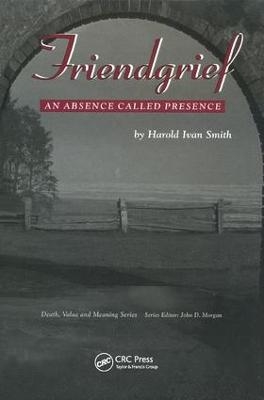
Friendgrief
Routledge (Verlag)
978-0-415-78470-2 (ISBN)
This book not only examines friendgrief from a theoretical and clinical framework, but also Smith offers fascinating vignettes from the lives of well-known friendgrievers such as Elton John, Diane Sawyer, Ralph Abernathy, C. S. Lewis, Harry Truman, Tommy Lasorda, Jimmy Carter, Fritz Mondale, Bill Clinton, Calvin Trillin, and Alan King. The author includes moving narratives of numerous individuals who have never gained notoriety but have become seasoned friendgrievers.
Harold Ivan Smith is a member of the American Academy of Bereavement, teaches at Saint Luke's Hospital in Kansas City, Missouri, and serves on the board of the Association for Death Education and Counseling. He is also a member of the Association for Death Education and Counseling and the National Hospice Association's Council of Professionals.
Chapter 1 Introduction Click to read the Introduction
Friends die. For many adults friendgrief is an occasional intrusion; for others a continual process: Who in my circle of friends will be next?
Chapter 2 Losing a Friend
Disenfranchisement of friendgrief is significant. Why should a clinician care about friendships or friendgrief? First, clinicians will have friends die. Secondly, clinicians will have clients devastated by the death of a friend. By understanding the dynamic nature of friendgrief, clinicians can be more resourceful.
Chapter 3 Defining a Friendship
What does one mean by "friend?" In a a clinical setting definition and clarification of operative terms are essential since a definition frames the parameters in which the friendship and the grief can be examined. Three broad categories of friendship are: "casual," "close," and "best" friend. Friendgrief is shaped by the definition of the friendship at the time of death.
Chapter 4 Recognizing the Friendorbit
The friendorbit, a sociological paradigm, will be introduced to understand the dynamics of friend networks and the impact of death and loss. The principles and components of the friendorbit model will be explained and used to illustrate the dynamic nature of friendships.
Chapter 5 Being Supportive Immediately After a Friend's Death
Historically, friends support the chief mourner and family members. Friendgrief must not compete with, overshadow, or complicate the grief of the family. This expectation motivates many friends to ignore their own grief and the needs of others in the friendorbit in order to concentrate on the needs of the family.
Chapter 6 Offering Hospitality
Friends offer hospitality. Rapid cultural change has significantly altered traditional expectations. How does a friend respond if family requests or demands are unreasonable? If other friends do not assume a reasonable share of hospitality. Offering hospitality may interfere with a friend acknowledging grief.
Chapter 7 Honoring a Friend by Attending the Visitation
What level of participation in prefuneral, funeral, and postfuneral rituals can be expected of a friend? An individual honors a friend by attending rituals such as the visitation; the funeral or memorial service; and prehaps, the committal or scattering. The visitation may be more valuable to friends than the funeral because it is conversation oriented while the funeral is liturgy or ritual focused.
Chapter 8 Honoring a Friend by Attending the Funeral/Memorial Service and Committal
Individuals honor friends by attending funerals. Attendance is an obligation, although in this culture in which death is increasingly privatized, many individuals have never attended a funeral for a peer. Mobility impacts attendance at rituals.
Chapter 9 Praying In Friendgrief
Although prayer and praying carry a great deal of emotional and spiritual baggage, individuals pray for deceased friends as a means of continuing bonds. Friends also pray for grace to reconcile with the loss.
Chapter 10 Pallbearing a Friend
Pallbearers participate in a contemporary reenactment of an ancient drama. The most historic way individuals, at least males, have demonstrated grief for friends: by carrying a friend to a final resting place. Bearing a friend's casket can be one of life's most sobering experiences.
Chapter 11 Eulogizing a Friend
The essential elements for a meaningful eulogy by a friend are: The friend-eulogist speaks as a representative; is grieving; and gives an accurate witness to the life of this particular friend. The friend-eulogist stimulates the memories of mourners, honestly remembers and affirms the deceased, and honors, sometimes creatively, the character of the deceased.
Chapter 12 Responding Graciously
Friends promise future assistance, touch, and validate. Making and redeeming promises are ways to maintain the bonds of friendship. Touching, although far more subjective, benefits the giver and the receiver. Friends may be asked to validate decisions of the chief mourner as well as others in the friendorbit.
Chapter 13 Remember Friends
The fear of being forgotten may be universal among humans. Remembering is an important act by a friend. Memory cannot be disenfranchised. Some friendorbits have the equivalent of the official "rememberer." It is important for friends to remember realistically.
| Erscheinungsdatum | 11.02.2017 |
|---|---|
| Reihe/Serie | Death, Value and Meaning Series |
| Verlagsort | London |
| Sprache | englisch |
| Maße | 152 x 229 mm |
| Gewicht | 453 g |
| Themenwelt | Geisteswissenschaften ► Psychologie ► Klinische Psychologie |
| Medizin / Pharmazie ► Medizinische Fachgebiete ► Notfallmedizin | |
| ISBN-10 | 0-415-78470-0 / 0415784700 |
| ISBN-13 | 978-0-415-78470-2 / 9780415784702 |
| Zustand | Neuware |
| Haben Sie eine Frage zum Produkt? |
aus dem Bereich


